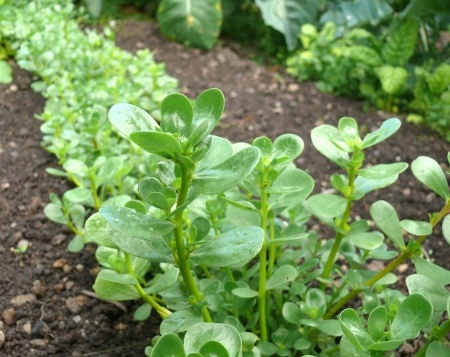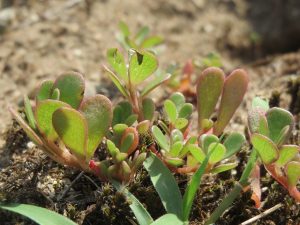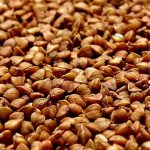
Purslane (Portulaca orelacea) is a succulent from the Portulacaceae family that runs riot, growing wild in dry salty areas, through cracks and gullies in the soil where moisture is hard to obtain.
Purslane is really a weed and is in the top eight most common plants of the world (Liu et al., 2000). On salad menus its adds a slight lemony tartness coupled with its crispiness for texture to counter the more bland munch of a lettuce. It can also be pickled and then served up in soups and sauces.
The herb was originally found throughout Asia but is now common throughout the world.
Nutritional Value
Significantly, it contains a rich source of vitamins and minerals and high amounts of the omega-3 fatty acid, eicosapentaenoic acid (EPA) and alpha-linolenic acid (ALA) (Simopoulos et al., 1992). The main vitamins of interest are vitamin A and vitamin C, small amounts of magnesium, calcium, iron and potassium.
P. oleracea is listed in the World Health Organization as one of the most frequently used medicinal plants and it has been given the term ‘Global Panacea’ (Chu et al., 2002; Katalinic et al., 2006). Even more interesting is its salt tolerance.
The Value Of Purslane As A Salt Tolerant Plant
As pressure for more agricultural land grows, the need to reclaim salt laden soils for pasture or food production rises. Purslane is halotolerant in some forms which makes it ideal for delivering bioactives for the pharma- or consumer healthcare oriented table. What has interested nutritionists is its range of antioxidants which are often reputed to reduce the risk of developing cancer and cardiovascular disease. These antioxidant levels are as high as other vegetables per unit weight such as carrots, spinach or chard which are easy to grow.
Being halotolerant means it competes successfully in those environments where other plants would simply wither away. To cope with salt stress, purslane manufactures a range of flavonoids and phenolics which counter free radical formation brought on by salt stress. One way is to accumulate large quantities of the amino-acid proline into their cytosol while sequestering both sodium and chlorine ions in their vacuoles. This allows them to manage and adjust the osmotic balance between both vacuole and cytosol (Yazici et al., 2007; Türkan & Demiral, 2009).
Dr Amirul Alam and fellow researchers at Universiti Putra Malaysia (UPM) in 2014 studied the links between purslanes ability to counter free radical damage and the salinity levels of the soils in which it grew (Alam et al., 2014a & b).
He says:-
“Plant materials containing high phenolic and carotenoid compounds are increasingly of interest for the food industry as they participate in the defence against ROS. Thus salinity-stressed plants might represent potential sources of bio-active [sic. antioxidant] compounds.“
In his team’s study, purslane samples from West Peninsular Malaysia were first grown in rice field topsoil for 30 days to become established. They were then treated with either pure water as the control or varying levels of salty water to each plant. The purslane was harvested and its biomass and antioxidant levels assessed. The salty water induced samples to have increasing higher levels of antioxidants but above 8 dSiemens per metre for a salt solution, the biomass levels dropped. There is a threshold level for saltiness above which plants will not grow successfully.
It does suggest though that plants with halotolerance might be suitable agricultural crops in areas where land has been freshly reclaimed from the sea. A very comprehensive review has been written about the plant (Zhou et al., 2015).
Successfully Growing Purslane As A Salad Crop
Purslane in cultivation needs full sun and ground which is free of weeds. It prefers dry soils and does not tolerate wet that readily.
Seeds are readily available from most reputable suppliers but it is feasible to collet seed from plants sourced as weeds in the garden. The seeds are best scattered or broadcast but with no coverage of them with soil. These seeds need light for germination which is why we would not recommend any coverage.

It is possible to take stem cuttings and place them on the ground. Stake into the soil to avoid them being blown away. Water these where they should eventually root into the soil. This is also a reasonably secure approach to developing a purslane bed.
Aftercare Of Purslane Plants
Purslane is easy to tend and in fact prefers to be left alone until it is harvested.
Regular cropping helps maintain a healthy supply. Cropping also helps prevent the plant becoming uncontrollable.
Reseeding after flowering is highly likely and to be encouraged given it is an annual. It may need some shepherding to avoid it becoming uncontrollable. Collect seeds from some of the plants for next years crop.
Avoid using herbicides in its vicinity as it is particularly prone to damage.
References
Alam, M. A., Juraimi, A. S., Rafii, M. Y., Abdul Hamid, A., Aslani, F., Hasan, M. M., … & Uddin, M. K. (2014a). Evaluation of antioxidant compounds, antioxidant activities, and mineral composition of 13 collected purslane (Portulaca oleracea L.) accessions. BioMed Research International, 2014.
Liu, L., Howe, P., Zhou, Y.F., Xu, Z.Q., Hocart, C., Zhang, R., (2000). Fatty acids and _-carotene in Australian purslane (Portulaca oleracaea) varieties. J. Chromatogr. A 893, pp. 207–213.
Simopoulos, A. P., Norman, H. A., Gillaspy, J. E., Duke, J. A. (1992). Common purslane: a source of omega-3 fatty acids and antioxidants. J. Amer. Coll. Nutr., 11(4), pp. 374-382.
Türkan, I., & Demiral, T. (2009). Recent developments in understanding salinity tolerance. Environmental and Experimental Botany, 67(1), pp. 2-9.
Yazici, I., Türkan, I., Sekmen, A. H., Demiral, T. (2007). Salinity tolerance of purslane (Portulaca oleracea L.) is achieved by enhanced antioxidative system, lower level of lipid peroxidation and proline accumulation. Environmental and Experimental Botany, 61(1), pp. 49-57.


We are looking for a supplier of this plant. Know anybody ?